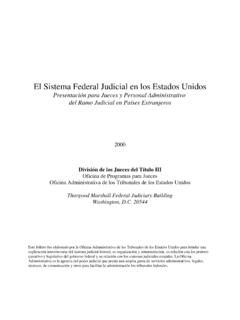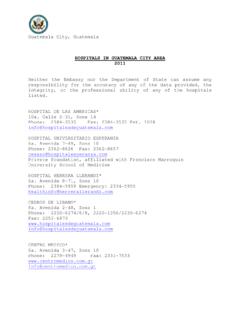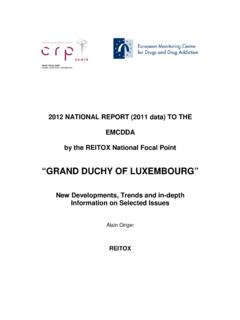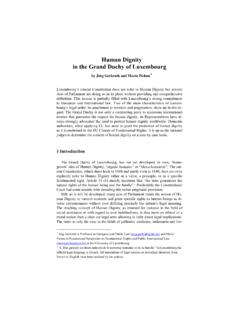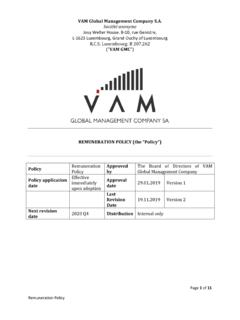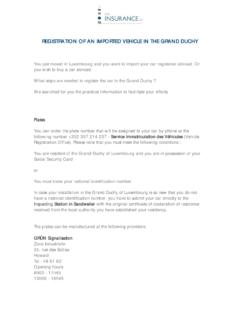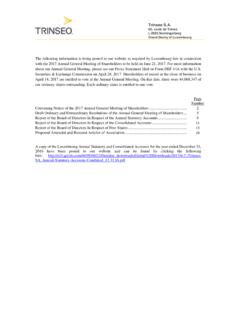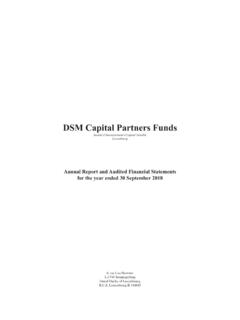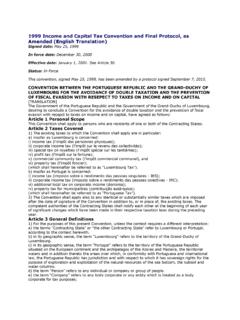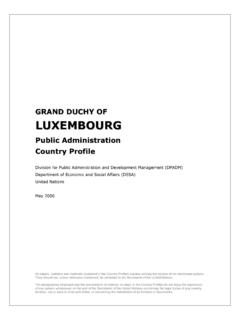Transcription of Everything you need to know about the Grand Duchy of ...
1 Grand Duchy of Luxembourgabout the Everything you need to know GeographyHistoryPolitical system National symbolsEconomy Population LanguagesEducationCulturePublisherInform ation and Press Service of the luxembourg Government, Publishing DepartmentTranslatorMarianne ChalmersLayoutRep res CommunicationPrintingImprimerie OSSAISBN 978-2-87999-206-8 April 2010 All statistics in this brochure are provided by Statec, unless otherwise a glance GeographyHistoryPolitical system National symbolsEconomy Population LanguagesEducationCulture4 6 8 12 14 16 18 20 24 26 Everything you need to know about the Grand Duchy of LuxembourgTable of contents4 Official designation Grand Duchy of LuxembourgCapital LuxembourgNational day 23 JuneCurrencyEuroGeographyGeographical coordinates Latitude 49 37 North and longitude 6 08 EastArea 2,586 km2, of which 86% is farmland or forest (2008)Neighbouring countries Belgium, Germany, FranceClimateLuxembourg enjoys a temperate climate without extremes of temperature.
2 Average temperatures range between 0 C in January and 18 C in July. TerritoryAdministrative division 3 districts ( luxembourg , Diekirch, Grevenmacher) 12 cantons (Capellen, Clervaux, Diekirch, Echternach, Esch-sur-Alzette, Grevenmacher, luxembourg , Mersch, Redange-sur-Attert, Remich, Vianden, Wiltz) 116 municipalities 4 electoral constituencies (South, East, Centre, North)Judicial division 2 judicial districts ( luxembourg , Diekirch) comprising 3 magistrates courts ( luxembourg , Esch-sur-Alzette, Diekirch)PopulationTotal population 502,066 inhabitants, including 215,550 foreign residents representing of the total population (January 2010)Most densely populated towns luxembourg (90,800 inhabitants) Esch-sur-Alzette (30,100 inhabitants) Differdange (21,500 inhabitants) (January 2010)LanguagesNational language L tzebuergeschAdministrative languages French, German, L tzebuergeschEverything you need to know about the Grand Duchy of LuxembourgAt a glance5 Political systemForm of government Parliamentary democracy within the framework of a constitutional monarchyHead of state HRH Grand Duke Henri (acceded to the throne on 7 October 2000) UsefUL aDDresses Service information et presse du gouvernement (Information and Press Service of the Government) 33, boulevard RooseveltL-2450 LuxembourgTel.
3 : (+352) central de la statistique et des tudes conomiques (Statec)(Central Service for Statistics and Economic Studies)Centre administratif Pierre Werner13, rue rasmeL-1468 LuxembourgTel.: (+352) national du tourisme(National Tourist Office)Gare centralePlace de la GareL-1616 LuxembourgTel.: (+352) 42 82 82 DiekirchDistrict GrevenmacherDistrict LuxembourgG E R M A N YFRANCEB E L G I U MRedange-sur-Attert6 The Grand Duchy of luxembourg is located at the heart of Western Europe between Belgium, Germany and France. It has two natural regions: Oesling in the north and Guttland, comprising the Moselle valley in the east and the mineral basin in the total area of the country is 2,586 km2, with Oesling covering 828 km2 and Guttland 1,758 capitalLuxembourg City lies 300 m above sea level. The capital offers a striking contrast between the modern town perched on a rocky plateau with a sheer drop and the three old quarters of Grund, Clausen and Pfaffenthal.
4 The quarter housing the European institutions has been located on the Kirchberg plateau to the north-east of the city since the 1960s. regionsThe variety of its landscapes is one of luxembourg s greatest attractions. The country is divided into two main regions, Oesling and Guttland. Oesling, in the north, forms part of the Ardennes massif and borders the German Eifel plateau. This wooded region covers one third of the country (32%) and is a magnet for tourists. The highest point in luxembourg is situated in this region rising to 560 m at Wilwerdange. There are villages on the uplands, as well as rivers and lakes. Oak and pine forests cover the steep slopes. The climate is harsher than in the rest of the country. The main towns in this region are Wiltz, Clervaux and The Troisvierges plateau in the north of Oesling is predominantly arable land with few forests. It is the coldest and wettest area of The Ardennes plateau, crossed by rivers, south of the Wiltz basin, is the most typical area of Oesling, with landscapes rich in contrasting forms and colours, plateaus and area on the boundary between Oesling and Guttland is one of the country s prime agricultural regions on account of its rich and varied soils.
5 Guttland ( good country ), in the south and centre of the country, occupies along with the capital the remainder of the territory (68%). It is made up essentially of fields and forests and comprises the following main regions:- luxembourg s sandstone plateau is the dominant feature of Guttland, where some of the country s finest forests are to be Marly depressions are the largest and most characteristic feature of the Guttland landscape. They extend to the foot of the Dogger and luxembourg sandstone escarpments and are made up of wide valleys. Over two thirds of this area is given over to The Moselle valley is the most impressive in luxembourg both in terms of size and variety of landscapes. It is one of the country s main tourist attractions, largely on account of its winemaking The Mullerthal region- luxembourg s Little Switzerland is located to the north of the Moselle valley along the border with Germany.
6 Its main town, Echternach, is one of the oldest in The Terres rouges (Red Lands) are situated to the south of the marly depressions. The area has been moulded by industry where iron ore has been extracted from the red earth, hence the name Minett (from minette , the designation for iron in the Lorraine) applied to this region in L tzebuergesch. The main towns are Esch-sur-Alzette, the second-largest town in the Grand Duchy , Differdange and The Valley of the Seven Castles boasts the castles of Mersch, Schoenfels, Hollenfels, the two castles of Ansembourg and also Septfontaines and Koerich, all within a 24 km area. They are part of a landscape of meadows and old villages which is perfect walking you need to know about the Grand Duchy of Luxembourg7 ClimateLuxembourg does not have a clearly defined climate; it ranges between the oceanic climate of the Atlantic zone (small seasonal variations, mild and wet winters) and the continental climate of the eastern European plains (pronounced seasonal variations, harsh winters and rainy summers).
7 Oceanic influence brings rain in all seasons and continental influence brings biting, dry weather in winter. The climate is temperate from May to mid-October. July and August are the hottest months, but May and June frequently have more sunshine. luxembourg often experiences its own version of an Indian summer in September and temperatures vary between 0 C in January and 18 C in July. In 2008, the average annual temperature was C (source: Service m t orologique de luxembourg [ luxembourg Meteorological Service]). There are slight variations in temperature between the north and south of the country due to the difference in altitude, but these rarely exceed 2 C. river networkThe four largest rivers in the Grand Duchy are the Moselle, S re, Our and Alzette. The other rivers are the Mess, Mamer, Eisch, Attert and the Wark in the west; the Wiltz, Clerve and Blees in the north; the White Ernz, Black Ernz, Syr and Gander in the east.
8 The P trusse is a minor river running through the city of luxembourg , before flowing into the the exception of the Chiers, which flows from the south-west of the country into the Meuse basin, luxembourg s rivers are tributaries of the Rhine basin by way of the divisionThe country is divided into 3 districts ( luxembourg , Diekirch, Grevenmacher), 12 cantons, 116 munici -palities and 4 electoral constituencies. The district of luxembourg comprises the cantons of luxembourg , Capellen, Esch-sur-Alzette and Mersch; the district of Diekirch consists of Diekirch, Clervaux, Redange-sur-Attert, Vianden and Wiltz; and the district of Grevenmacher is made up of Grevenmacher, Echternach and commissioners play a supervisory role and act as intermediaries between government and local authorities. UsefUL aDDresses Office national du tourisme(National Tourist Office)Gare centralePlace de la GareL-1616 LuxembourgTel.
9 : (+352) 42 82 82 Christof Weber/SIP8 luxembourg s originsThe name luxembourg (Lucilinburhuc) first appears in around 963 in a deed of barter in which Count Siegfried acquired the abbey of St Maximin of Trier, a small fort situated on the Bock promontory, a rocky outcrop dominating the Alzette valley. This fortified site became a foothold, allowing the counts of luxembourg to accumulate territory over the course of the 11th, 12th and 13th centuries. By the late 13th century, the County of luxembourg occupied a vast area stretching from the Meuse to the the house of luxembourg to the Habsburg dynasty At the start of the 14th century, the house of luxembourg acceded to the imperial throne and played a major role on the European stage. In 1308, Count Henry VII was elected king of Germany by the prince-electors and crowned emperor in Rome by the papal legate in 1312. His son, known as John the Blind, became king of Bohemia.
10 Three other members of the luxembourg dynasty bore the royal or imperial crown in succession: Charles IV (1346-1378), Wenceslas (1376-1400) and Sigismund (1410-1437). In 1354, Charles IV promoted the County of luxembourg to the rank of Duchy . The male luxembourg line died out with Emperor Sigismund in 1437. In 1443, the Duke of Burgundy, Philip the Good, conquered the town of luxembourg . The Duchy of luxembourg then became a province of the Netherlands. Its fate was to be allied to this territorial entity for the next four centuries. The Duchy belonged to the Burgundians (15th century), the Spanish Habsburgs (16th and 17th centuries) and the Austrian Habsburgs (18th century) in succession, with a brief period of French rule between 1684 and 1697. luxembourg occupied an important strategic position on the European chessboard. The town of luxembourg was gradually transformed into a formidable fortress dubbed the Gibraltar of the North , which European powers fought to control.




